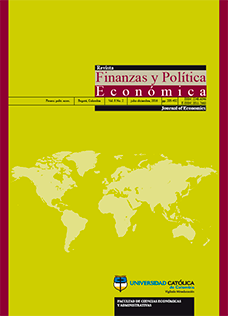This journal is licensed by a Creative Commons Attribution License (CC BY-NC-SA 4.0) Attribution-Non Commercial 4.0 International. For the CC licenses, the principle isthe creative freedom. This system complements the copyright without opposing it, conscious of its importance in our culture. The content of the articles is the responsibility of each author, and does not compromise in any way, to the journal or the university. It allows the transmission and reproduction of titles, abstracts and full content, with academic, scientific, cultural ends, provided acknowledgment of the respective source. This work cannot be used for commercial purposes.
They journal does not charge authors for submission or publication.
Abstract
This article evaluates the Fisher hypothesis and the hypothesis of the integration of Latin American markets through co-integration and endogenous structural change tests. The findings suggest a number of conclusions: a) the Fisher effect is validated mainly in Costa Rica; b) the international Fisher effect is validated weakly between Chile and Costa Rica and between Colombia and Mexico; c) the integration of counties and markets is heterogeneous, and d) only Chile did not present structural changes. The study uses monthly series for Brazil, Chile, Colombia, Costa Rica, Mexico and Peru during the January 1997 to December 2014 period.

References
Argandoña, A. (2013). Irving Fisher: un gran economista (WorkingPaper WP-1082). Barcelona: IESE Business School y Universidad de Navarra.
Badillo, R., Reverte, C. y Rubio, E. (2010). Contrastación empírica del efecto Fisher en la Unión Europea mediante técnicas de cointegración con datos de panel. Cuadernos de Economía y Dirección de la Empresa, 44, 101-120.
Barquero, J. P. y Muñoz, E. (2015). Costa Rica: tipo de cambio real y zona de equilibrio (Documento de Trabajo DT-06-2015). San José: Banco Central de Costa Rica.
Baum, C. (2005). Stata: The language of choice for time-series analysis? Stata Journal, 5(1), 46-63.
Baxter, M. (1994). Real exchange rates and real interest differentials. Have we missed the business-cycle relationship? Journal of Monetary Economics, 33(1), 5-37.
Berument, H. y Jelassi, M. M. (2002). The Fisher hypothesis: A multi-country analysis. Applied Economics, 34(13), 1645-1655.
Brooks, C. (2008). Introductory econometrics for finance (2.a ed.). Nueva York: Cambridge University Press.
Carneiro, F. G., Divino, J. A. y Rocha, C.H. (2002). Revisiting the Fisher hypothesis for the cases of Argentina, Brazil and Mexico. Applied Economics Letters, 9(2), 95-98.
Comin, D. A., Lashkari, D. y Mestieri, M. (2015). Structural change with long-run income and price effects(NBER Working Paper 21595). Cambridge: National Bureau of Economic Research.
Cooray, A. (2003). The Fisher effect: A survey. The Singapore Economic Review, 48(2), 135-150.
Eiteman, D. K., Stonehill, A. I. y Moffett, M. H. (2013). Multinational business finance (13.a ed.). Upper Saddle River: Pearson.
Fama, E. F. (1970). Efficient capital markets: A review of theory and empirical work. Journal of Finance, 25(2), 383-417.
Fisher, I. (1930). The theory of interest as determined by impatience to spend income and opportunity to spend It. Nueva York: Macmillan.
Gaab, W., Granziol, M. J. y Horner, M. (1986). On some international parity conditions: An empirical investigation. European Economic Review, 30(3), 683-713.
Garcia, M. G. (1993). The Fisher effect in a signal extraction framework: The recent Brazilian experience. Journal of Development Economics, 41(1), 71-93.
Ghali, K. y Eid, M. B. (2006). Transaction costs, structural change and the integration of international financial markets: An analysis of interests rates in ten OECD countries, 1980-2000. Applied Econometrics and International Development, 6(3), 23-38.
Granville, B. y Mallick, S. (2004). Fisher hypothesis: UK evidence over a century. Applied Economics Letters, 11(2), 87-90.
Greene, W. H. (2012). Econometric analysis (7.a ed.). Upper Saddle River: Prentice Hall.
Hatemi-J, A. (2008). Tests for cointegration with two unknown regime shifts with an application to financial market integration. Empirical Economics, 35(3), 497-505.
Hatemi-J, A. (2009). The international Fisher effect: Theory and applications. Investment Management and Financial Innovations, 6(1), 117-121.
Johansen, S. (1991). Estimation and hypothesis testing of cointegration vectors in Gaussian Vector Autoregressive models. Econometrica, 59(6), 1551-1580.
Juselius, K. y MacDonald, R. (2004). International parity relationships between the US and Japan. Japan and the World Economy, 16(1), 17-34.
MacKinnon, J. G., Haug, A. A. y Michelis, L. (1999). Numerical distribution functions of likelihood ratio tests for cointegration. Journal of Applied Econometrics, 14(5), 563-577.
Martin, A. (2013). Financial integration and structural changes in Spanish Banks during the pre-crisis period. Revista de Estabilidad Financiera, 24, 109-123.
Mendoza, E. G. (1992). Fisherian transmission and efficient arbitrage under partial financial indexation: The case of Chile. IMF Staff Papers, 39(1), 121-147.
Omay, T., Yuksel, A. y Yuksel, A. (2015). An empirical examination of the generalized Fisher effect using cross-sectional correlation robust tests for panel cointegration. Journal of International Financial Markets, Institutions and Money, 35(1), 18-29.
Oxelheim, L. (1990). International financial integration. Berlín: Springer-Verlag.
Phylaktis, K. y Blake, D. (1993). The Fisher hypothesis: Evidence from three high inflation economies. Weltwirtschaftliches Archiv, 129(3), 591-599.
Ruiz, A. y Anguiano, J. E. (2016). Cointegración, causalidad y cambio estructural en la región del TLCAN: Un análisis de tasas de interés, tipos de cambio y precios. En V. H. Torres, M. Polanco y M. A. Tinoco (coords.), Desafíos de la economía mexicana: sector externo. Colima: Universidad de Colima.
Solnik, B. (1978). International parity conditions and exchange risk: A review. Journal of Banking and Finance, 2(3), 281-293.
Thornton, J. (1996). The adjustment of nominal interest rates in Mexico: A study of the Fisher effect. Applied Economics Letters, 3(4), 255-257.
Westerlund, J. (2008). Panel cointegration tests of the Fisher effect. Journal of Applied Econometrics, 23(2), 193-233.
Zivot, E. y Andrews, D. K. (1992). Further evidence on the Great Crash, Oil Price Shock and the unit root hypothesis. Journal of Business and Economic Statistics, 10(3), 251-270.





























